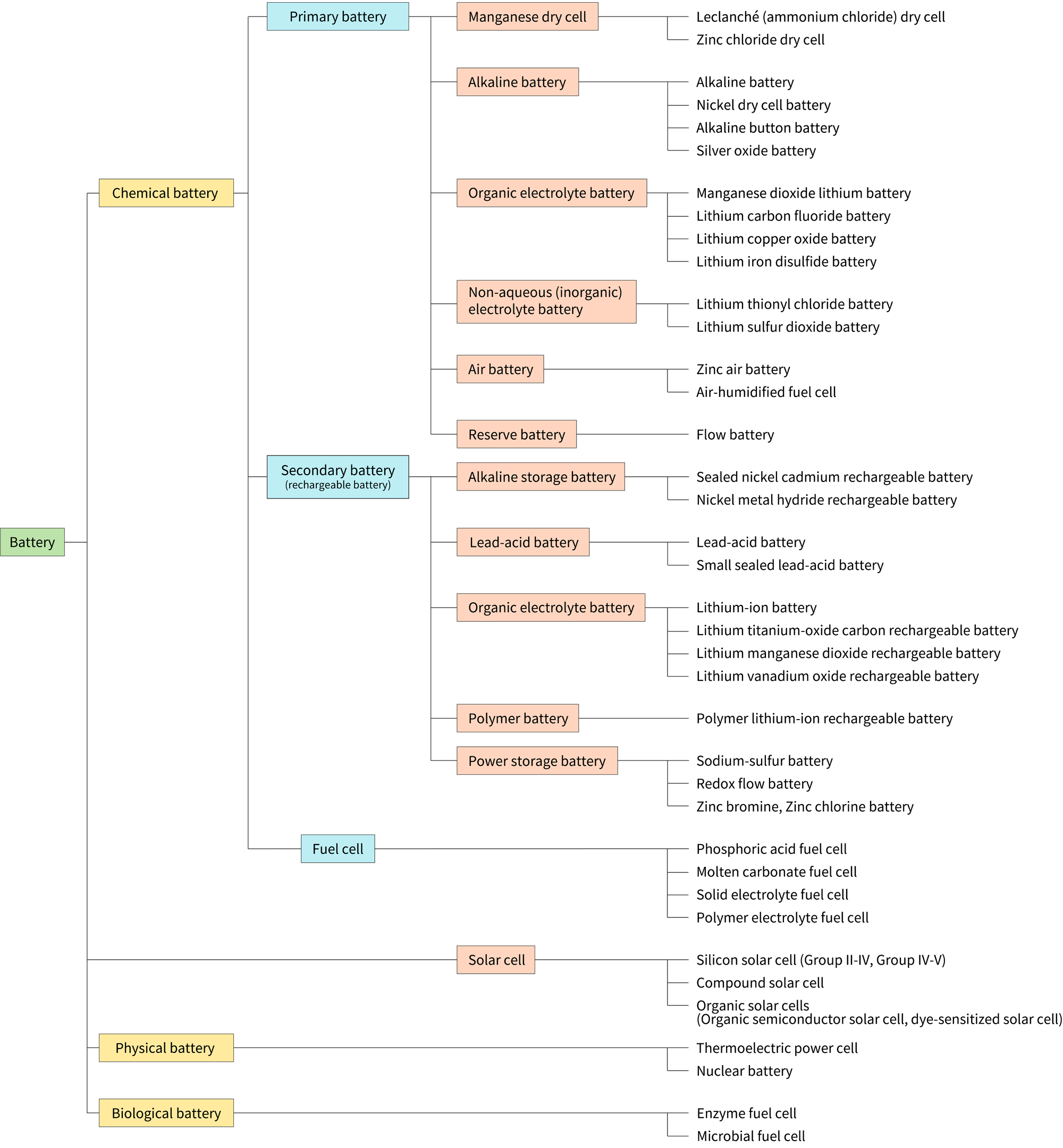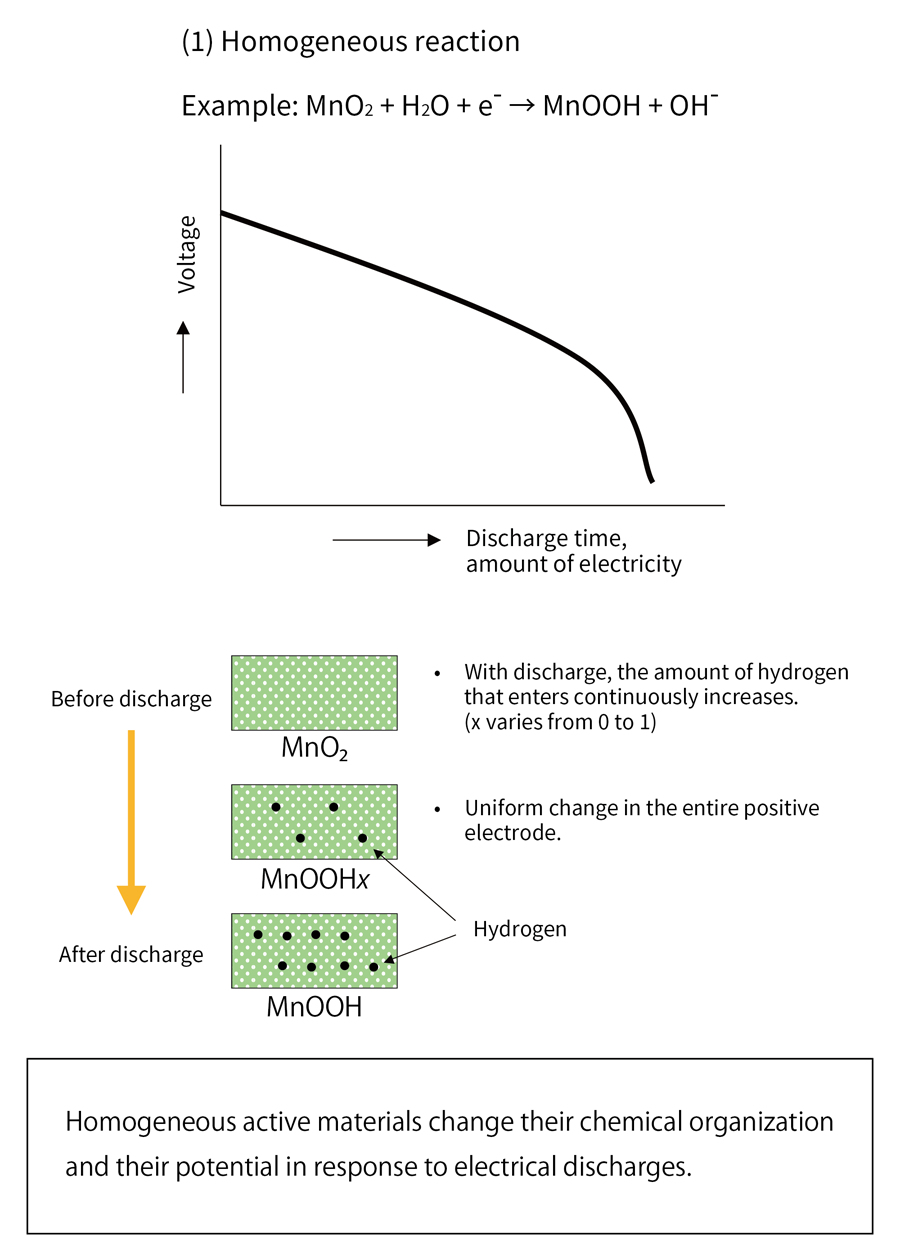Technical article: Basic knowledge of batteries
| The origins of technological innovation | ||
| History and basic principles of batteries |
Maxell micro batteries
Maxell was the first company in Japan to commercialize silver oxide button batteries in 1976. At that time, Japanese watches were taking the world by storm with their quartz technology, and together with the continuing evolution of compact electronic devices such as hand-held calculators, the need for micro batteries continues to grow to this day.
Types of batteries
A battery can be described as a system in which chemical substances in the positive and negative electrodes convert the energy changes of their redox reactions into electrical energy. Therefore, there are various types of batteries depending on the combination of materials. The history of batteries can be traced back as far as 1791, when Luigi Galvani (Italy)discovered (bio) electricity from a phenomenon in which the legs of a frog connected to a metal object moved, causing muscle contractions. The origin of today's chemical batteries is said to be the invention of the Leclanché battery, which later became the prototype of the dry cell, by Georges Leclanché in 1868, after Alessandro Volta invented the battery in around 1800. Although batteries have a very long history, they make up an extremely rare technological field that continues to be innovated. In particular, batteries are a technology supporting recent technological innovations in the world today, such as electronic devices in the form of mobile phones, smartphones, and laptops, as well as technological innovation in electric vehicles.
This section explains the basic mechanisms of chemical batteries, using the primary batteries that Maxell has developed, manufactured, and sold for many years as an example.

Types of batteries
Battery mechanism
The following describes the most commonly used type of battery, the chemical battery (hereinafter referred to as "battery"). A battery can be defined as a power generation device that converts the energy possessed by a chemical substance directly into direct current electrical energy through a chemical reaction of that substance. Focusing on the reaction itself, it can be said that the function of a battery is to have a substance that receives electrons (oxidizing agent) at the positive electrode and a substance that releases electrons (reducing agent) at the negative electrode, and to transfer the electrons generated by the redox reaction to an external circuit.
How batteries harness chemical energy to generate electricity
Next, we will explain a redox reaction, which is the origin of battery functionality. One of the most familiar redox reactions is the combustion of substances. For example, the combustion of hydrogen produces water.
(Redox reactions in combustion reactions)
Combustion of hydrogen: O2(oxidizing agent) + 2H2(reducing agent) → 2H2O (∗)
Thus, in the combustion reaction of hydrogen, hydrogen acts as a reducing agent and oxygen acts as an oxidizing agent.
Now, to focus on the transfer of electrons in the combustion reaction of hydrogen, we shall take a look at the above hydrogen and oxygen reaction in a battery. In the case of a battery reaction, the reaction at the positive and negative electrodes proceeds through the movement of ions in the electrolyte.
Positive electrode (reduction reaction): O2 + 2H2O + 4e- → 4OH-
Negative electrode (oxidation reaction): 2H2 + 4OH- → 4H2O + 4e-

Water electrolysis
Electrical energy can be obtained in the external circuit through the movement of electrons (e-) generated in this reaction in the connected external circuit with these electrodes.
These reactions can be combined and expressed as the overall reaction formula below.
Overall reaction: O2 + 2H2 → 2H2O
This is the same reaction formula (∗) for the combustion reaction of hydrogen. Therefore, we see that the battery reaction is a similar redox reaction involving hydrogen and oxygen from a chemical perspective of a reaction that produces water.
On the other hand, unlike the combustion reaction, in the battery reaction, electrons move through an external circuit and little heat is generated (no energy is lost), which means that the battery is a device that efficiently converts chemical energy into electrical energy.
This very simple principle and the resulting energy efficiency as an electrical device are the reasons why batteries (chemical batteries) have been used for a long time, and it is expected that this will not change significantly in the future.
Three elements that make up a battery
We would like to further delve into the key materials that make up a battery. The first three key elements that determine battery performance are the positive electrode active material, negative electrode active material, and electrolyte.
Positive electrode active material: A material that receives electrons during battery reactions. Generally, oxidizing agents are often used.
Example: O2, Ag2O, MnO2, ...
Negative electrode active material: A material that releases electrons during battery reactions. Generally, reducing agents are often used.
Example: H2, Zn, Li, ...
Electrolyte: Ionic conductor (through which ions move)
Anion (negative ion): positive electrode → negative electrode
Cation (positive ion): negative electrode → positive electrode
Examples: Acidic aqueous solution, alkaline aqueous solution, non-aqueous electrolyte
In the process of these reactions, the ease of movement of electrons flowing through the external circuit is much greater than that of ions moving in the electrolyte. A major factor responsible for the moving speed of ions is the ionic conductivity of the electrolyte, which limits the current to the external circuit (electronics). This is commonly referred to as the internal resistance of the battery and is one of the main indicators of battery performance.
In other words, it is technically important to reduce the internal resistance of the battery, including the electrolyte, in order for it to be used in electronic devices. For this reason, batteries with electrolytes dissolved in water or organic solvents have been widely used. In recent years, the discovery of solid electrolyte materials that exhibit high ionic conductivity similar to that of liquid electrolytes, even in the solid state, has led to technological innovations in solid electrolyte batteries (all-solid-state batteries), a technological background that has attracted considerable attention.
How battery voltage is determined
There are various types of batteries used today, and their electrical performance also varies. For example, the difference in battery voltage comes from the materials (active materials) used for the positive and negative electrodes, and it is possible to create various types of batteries.
The origin of the battery reaction is a redox reaction, but the oxidizing and reducing power of each substance can be either strong or weak, and the order of their strengths is explained by the standard electrode potential.
As an example, if the electrode potential of a standard hydrogen electrode (SHE) is 0 V, we see that the silver oxide battery shows a battery potential of (+0.80 V) - (-0.76 V) = +1.56 V, because the positive electrode is silver oxide (Ag2O) and the negative electrode is zinc (Zn).
In this way, the battery voltage is determined by the selection of the positive and negative electrode active materials. This means that the only way to change the battery voltage is by changing the type of battery (type of active material). Lithium-ion batteries, which are often used in portable devices, also have an image of being around 4 V, but different types of Li-ion batteries with different voltages employing different active materials are used in different applications.
Battery voltage: Determined by the type and combination of positive and negative active materials used
Examples of main active materials are shown in the table (all are theoretical values and actual battery voltages will vary).

Redox potential of the main active materials
Factors that determine the discharge curve of a battery
So what causes the shape of a battery discharge curve (the change in battery voltage due to discharge)? It is the difference in the way the active materials used in the battery reaction. Active materials are substances that are used in the positive and negative electrodes of a battery and are themselves responsible for oxidation or reduction. For example, silver oxide batteries use silver oxide as the active material for the positive electrode and zinc as the active material for the negative electrode.
Battery discharge curve: The shape of the discharge curve changes depending on how the positive and negative active materials react
The reactions of these active materials can be divided into (1) homogeneous reactions and (2) heterogeneous reactions.
In a homogeneous reaction, as the battery discharges, the state of the active material changes uniformly and the voltage gradually decreases. In other words, the discharge curve gradually decreases as shown in (1). In a heterogeneous reaction, on the other hand, as the battery discharges, the active material is divided into a discharged portion and an undischarged portion, and the reaction proceeds under the coexistence of two phases. Thus, the reaction proceeds unevenly, and the discharge curve exhibits flat behavior as shown in (2).


Homogeneous and heterogeneous reactions
From the viewpoint of electronic devices that use batteries, discharge curves such as (1) can be used to detect remaining battery capacity by taking advantage of the fact that the battery voltage decreases as the battery discharges. On the other hand, with a flat discharge curve as in (2), the voltage does not change significantly from the beginning to the end of use, which is a great advantage for devices that require a constant voltage to drive them. For example, in early quartz watches, the battery voltage often affected the accuracy of the watch, and silver oxide batteries (SR batteries) with flat voltage curves derived from heterogeneous reactions were mainly used. This is mainly derived from the way these reactions occur, but the discharge curve may also change depending on other characteristics of the substance.
The ever-evolving battery
As mentioned above, battery technology has its origins in the old days, but it offers a variety of possibilities depending on the combination of materials, and technological developments such as lithium-ion batteries and all-solid-state batteries are still being actively pursued. Maxell will continue to meet customer needs with its wide product lineup, technologies developed over many years, and new technological innovations.
Related products
Inquiry form related to batteries
We look forward to hearing from you regarding selection of battery products, sample consultations, etc. Please feel free to contact Maxell.


